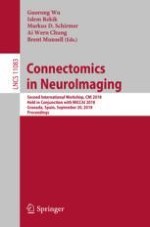2018 | OriginalPaper | Chapter
Intact Connectional Morphometricity Learning Using Multi-view Morphological Brain Networks with Application to Autism Spectrum Disorder
Authors : Alaa Bessadok, Islem Rekik
Published in: Connectomics in NeuroImaging
Publisher: Springer International Publishing
Activate our intelligent search to find suitable subject content or patents.
Select sections of text to find matching patents with Artificial Intelligence. powered by
Select sections of text to find additional relevant content using AI-assisted search. powered by
